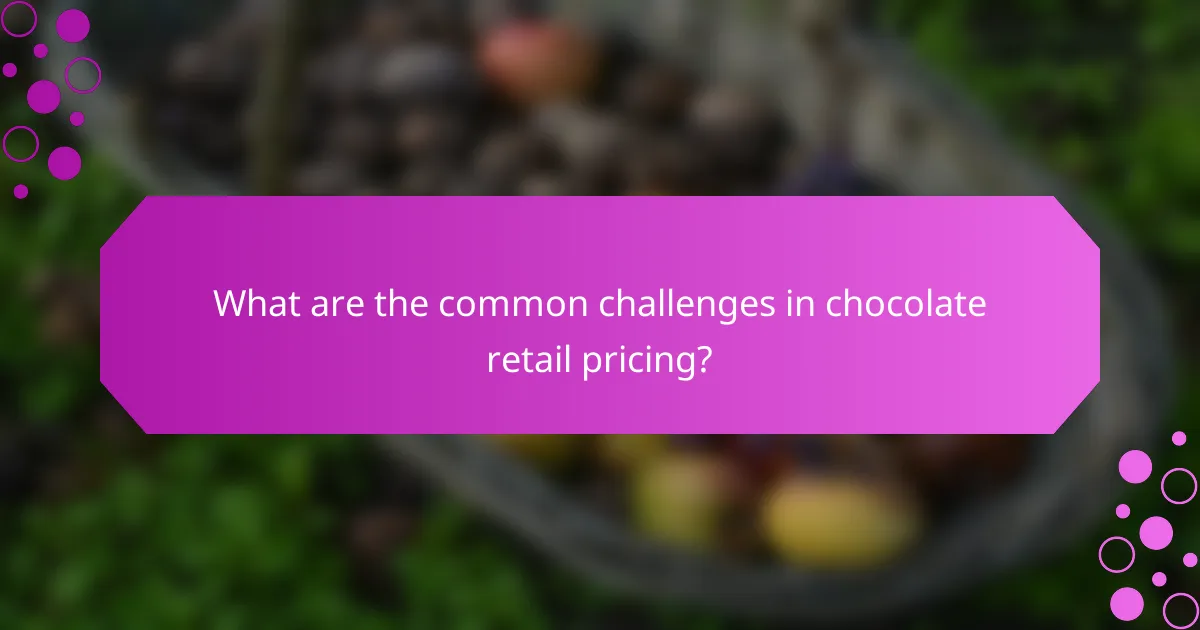In the competitive landscape of chocolate retail, effective pricing strategies are essential for success. Retailers must carefully consider approaches such as cost-plus, competitive, and value-based pricing to attract consumers while navigating market dynamics. Understanding the target audience and establishing a strong brand reputation further enhance market positioning, allowing chocolate brands to differentiate themselves and thrive in a crowded marketplace.

What are effective pricing strategies for chocolate retail in Australia?
Effective pricing strategies for chocolate retail in Australia include cost-plus pricing, competitive pricing, value-based pricing, dynamic pricing, and promotional pricing. Each strategy has unique advantages and considerations that can help retailers position themselves in a competitive market while appealing to consumers.
Cost-plus pricing
Cost-plus pricing involves calculating the total cost of producing a chocolate product and adding a markup percentage to determine the selling price. This strategy ensures that all costs are covered and a profit margin is achieved. Retailers should consider their production costs, including ingredients, labor, and overhead, when setting prices.
A common markup in the chocolate industry can range from 30% to 50%, depending on the product type and market demand. Retailers must regularly review their costs to adjust prices accordingly and maintain profitability.
Competitive pricing
Competitive pricing sets chocolate prices based on what competitors charge for similar products. This strategy helps retailers remain attractive to price-sensitive consumers. It requires ongoing market analysis to ensure prices are aligned with competitors while still allowing for profitability.
Retailers can use tools like price comparison websites or competitor audits to gather data on pricing trends. It’s essential to balance competitive pricing with product quality to avoid being perceived as a low-cost option if the product quality is premium.
Value-based pricing
Value-based pricing focuses on the perceived value of chocolate products to consumers rather than just production costs. This strategy allows retailers to charge higher prices for premium or unique offerings, such as organic or artisanal chocolates. Understanding customer preferences and willingness to pay is crucial.
Retailers should conduct market research, such as surveys or focus groups, to gauge consumer perceptions. Highlighting unique selling points, like sustainability or local sourcing, can enhance perceived value and justify higher prices.
Dynamic pricing
Dynamic pricing adjusts chocolate prices in real-time based on market demand, competition, and other factors. This strategy is particularly useful during peak seasons, such as holidays, when demand for chocolate typically increases. Retailers can use software tools to automate pricing adjustments based on predefined criteria.
While dynamic pricing can maximize profits, it may also lead to customer dissatisfaction if prices fluctuate too frequently. Retailers should communicate clearly with consumers about pricing changes to maintain trust and loyalty.
Promotional pricing
Promotional pricing involves temporarily reducing prices to stimulate sales or attract new customers. This strategy can include discounts, buy-one-get-one-free offers, or seasonal sales. Promotional pricing can effectively increase foot traffic and boost brand awareness.
Retailers should carefully plan promotional campaigns to ensure they do not undermine perceived value. Setting clear objectives, such as increasing market share or clearing inventory, can help guide promotional pricing decisions. It’s also important to monitor the impact of promotions on overall profitability.

How does competition affect chocolate retail pricing?
Competition significantly influences chocolate retail pricing by driving prices down or up based on market dynamics. Retailers must navigate competitor pricing, consumer preferences, and overall market demand to establish their own pricing strategies.
Market share analysis
Understanding market share is crucial for chocolate retailers as it helps gauge the competitive landscape. Retailers with a larger market share can often afford to lower prices due to economies of scale, while smaller players may need to maintain higher prices to cover costs. Analyzing competitors’ market shares can reveal pricing trends and consumer preferences.
Price wars
Price wars occur when retailers aggressively lower prices to outcompete each other, which can significantly impact profit margins. In the chocolate market, this can lead to unsustainable pricing practices, where retailers may sell at a loss to attract customers. Retailers should be cautious of entering price wars, as they can erode brand value and customer loyalty.
Brand positioning
Brand positioning plays a vital role in how chocolate retailers set their prices. Premium brands often command higher prices due to perceived quality and unique offerings, while mass-market brands compete on price. Retailers should clearly define their brand positioning to align pricing strategies with consumer expectations, ensuring they attract the right target audience without compromising profitability.

What are the key factors in market positioning for chocolate brands?
Market positioning for chocolate brands hinges on understanding the target audience, defining unique selling propositions, and maintaining a strong brand reputation. These elements help brands differentiate themselves in a competitive landscape and appeal to specific consumer segments.
Target audience segmentation
Identifying target audience segments is crucial for chocolate brands to tailor their marketing efforts effectively. Segmentation can be based on demographics, such as age and income, or psychographics, including lifestyle and preferences. For instance, premium chocolate brands often target affluent consumers seeking luxury experiences, while mass-market brands may focus on families looking for affordable treats.
Brands should conduct market research to understand the preferences and buying behaviors of their segments. This can involve surveys, focus groups, or analyzing sales data to identify trends and preferences that inform product development and marketing strategies.
Unique selling propositions
Unique selling propositions (USPs) are essential for chocolate brands to stand out in a crowded market. A strong USP highlights what makes a brand different, whether it’s organic ingredients, artisanal production methods, or innovative flavors. For example, a brand that specializes in vegan chocolate can attract health-conscious consumers looking for dairy-free options.
Brands should clearly communicate their USPs through packaging, advertising, and social media. This not only helps in attracting the right customers but also reinforces brand loyalty by aligning with consumer values and preferences.
Brand reputation
Brand reputation plays a significant role in market positioning for chocolate brands. A positive reputation can lead to increased customer trust and loyalty, while negative perceptions can deter potential buyers. Factors influencing reputation include product quality, ethical sourcing practices, and customer service.
To build and maintain a strong reputation, brands should prioritize transparency and engage with their customers. This can involve sharing information about sourcing practices, responding to customer feedback, and participating in community initiatives. Regularly monitoring brand sentiment through social media and reviews can also help brands address issues proactively.

What are the common challenges in chocolate retail pricing?
Chocolate retail pricing faces several challenges that can impact profitability and market positioning. Key issues include supply chain fluctuations, consumer price sensitivity, and seasonal demand variations, each requiring strategic consideration to maintain competitive pricing.
Supply chain fluctuations
Supply chain fluctuations can significantly affect chocolate pricing due to factors like raw material availability, transportation costs, and production delays. For example, if cocoa prices rise due to poor harvests, retailers may need to adjust their prices accordingly to maintain margins.
To mitigate these fluctuations, retailers should establish strong relationships with suppliers and consider diversifying their sourcing options. This can help buffer against sudden price increases and ensure a more stable supply chain.
Consumer price sensitivity
Consumer price sensitivity varies widely in the chocolate market, influenced by brand loyalty, product quality, and economic conditions. Many consumers are willing to pay a premium for high-quality or artisanal chocolates, while others may seek more affordable options, especially during economic downturns.
Retailers should conduct market research to understand their target audience’s price sensitivity and adjust their pricing strategies accordingly. Offering promotions or loyalty programs can also help attract price-sensitive customers without compromising overall brand value.
Seasonal demand variations
Seasonal demand variations are common in the chocolate industry, particularly around holidays like Valentine’s Day and Christmas. During peak seasons, demand can surge, allowing retailers to increase prices, but off-peak periods may require discounts to stimulate sales.
To navigate these fluctuations, retailers should plan their inventory and pricing strategies well in advance. Implementing targeted marketing campaigns during peak seasons can help maximize sales, while maintaining a flexible pricing approach during slower periods can prevent excess inventory buildup.

How can chocolate retailers leverage online platforms for pricing?
Chocolate retailers can effectively use online platforms to optimize their pricing strategies by analyzing consumer behavior and market trends. By leveraging digital tools, retailers can adjust prices dynamically and enhance their competitive positioning in the market.
Utilizing e-commerce analytics
E-commerce analytics provides valuable insights into customer preferences, purchasing patterns, and pricing effectiveness. Retailers should track metrics such as conversion rates, average order value, and cart abandonment rates to identify pricing opportunities. For instance, if a particular chocolate product shows high interest but low sales, it may indicate that the price is too high.
Implementing tools like Google Analytics or specialized e-commerce platforms can help retailers gather data on customer interactions. This information can guide pricing adjustments to better align with consumer expectations and increase sales.
Implementing A/B testing
A/B testing allows chocolate retailers to compare two pricing strategies to determine which one performs better. By presenting different prices to similar customer segments, retailers can assess the impact on sales and customer engagement. For example, offering a discount on one version of a product while keeping another at full price can reveal price sensitivity among shoppers.
It’s crucial to run tests for a sufficient duration to gather meaningful data, ideally over several weeks. Retailers should also ensure that they are testing one variable at a time to accurately measure the effect of pricing changes.
Optimizing for mobile shopping
With a growing number of consumers shopping on mobile devices, chocolate retailers must ensure their pricing strategies are mobile-friendly. This includes displaying prices clearly and ensuring that the checkout process is streamlined for mobile users. Retailers should consider implementing features like one-click purchasing to enhance the shopping experience.
Additionally, retailers should monitor mobile-specific analytics to understand how pricing impacts mobile sales. Offering exclusive mobile discounts or promotions can also incentivize purchases and increase customer loyalty in this segment.
